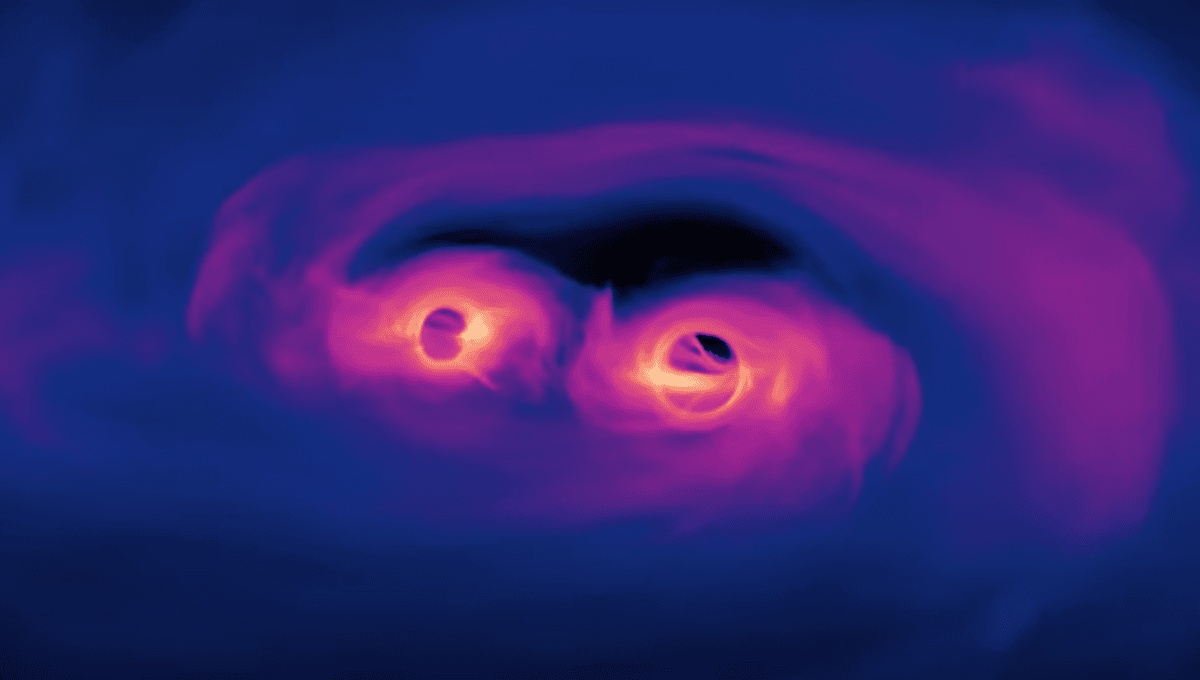
Theoretical dark matter particles could explain how supermassive black holes (SMBHs) at the heart of galaxies merge. The idea could also make sense of some unexplained features of dark matter behavior on vastly larger scales.
SMBHs are key to understanding many of the most important features of the universe, from the light of astonishingly distant quasars to the way elements are dispersed through the galaxy. However, we still don’t understand some of their most important behaviors, including how they merge. The so-called “final parsec problem” refers to the fact that models of galaxy mergers indicate that mergers of the supermassive black holes at their core should not be very rare. Instead, the models suggest, they should usually draw closer until they are a few light years apart, but only cross that last gap with glacial slowness.
Although we see some examples of SMBHs orbiting each other, there are also plenty of cases of merged galaxies with a single SMBH. Moreover, if SMBHs hardly ever merge, it’s hard to explain how some get so staggeringly huge. There is also evidence, albeit not yet conclusive, of a gravitational wave background produced by such mergers affecting the timing of pulsars. Somehow, it seems, many find a way to cross that final parsec (3.26 light-years). A new paper proposes dark matter particles are key.
SMBHs don’t repel each other like particles of the same charge, so one way for them to merge is through head-on collisions. This, however, is far too rare to account for the observed distribution. More frequently, they fall into a mutual orbit, just as their smaller counterparts, stellar black holes, sometimes do. In both cases, the distance slowly decays with gravitational waves carrying away some of the energy.
However, SMBHs are so enormous that their orbits carry phenomenal amounts of energy. For this to be dispersed quickly requires the transfer to nearby matter, a process known as dynamical friction. Initially, dynamical friction works well, but the matter that receives the transferred energy quickly leaves the area, that being the inevitable consequence of a kinetic energy boost. Once the SMBHs have cleared their vicinity of matter, dynamical friction stops. If gravitational waves become the only method by which energy is dispersed, the pace of approach would slow to a point where mergers should take longer to occur than the current age of the universe.
Therefore, physicists have reasoned, there must be some other process dispersing energy, but its nature has remained a mystery. A team led by Dr Gonzalo Alonso-Álvarez of the University of Toronto thinks they have the solution.
“We show that including the previously overlooked effect of dark matter can help supermassive black holes overcome this final parsec of separation and coalesce,” Alonso-Álvarez said in a statement. “Our calculations explain how that can occur, in contrast to what was previously thought.”
Since we don’t know what dark matter is, we can’t be sure of how its particles will behave, particularly in circumstances as extreme as this. Previous models assumed any dark matter in SMBHs’ vicinity would also be accelerated out, so that by the time the SMBHs were a parsec or so apart there would not be enough left to cause much further orbital decay.
However, Alonso-Álvarez and co-authors considered an alternative, that interactions between the dark matter particles prevent their dispersal. “The possibility that dark matter particles interact with each other is an assumption that we made, an extra ingredient that not all dark matter models contain,” Alonso-Álvarez said. “Our argument is that only models with that ingredient can solve the final parsec problem.”
Without finding such particles and watching them interact, the team cannot be certain they are right, but there are more practical tests that would boost confidence. In particular, if they are right the low-frequency end of gravitational waves produced by SMBHs should show a specific signature. “The current data already hint at this behavior, and new data may be able to confirm it in the next few years,” said co-author Professor James Cline of McGill University.
Dark matter particles can’t interact if they don’t exist. Most physicists are confident they do, but our failure to find these particles has, in recent years, led a minority who dispute the idea to become more vocal. If SMBH gravitational waves show the pattern the authors expect, it would set any doubts about dark matter’s existence to rest, even if we still couldn’t identify the particles themselves.
Such confirmation would also expand the little we do know about dark matter, with wider implications. “Our work is a new way to help us understand the particle nature of dark matter,” said Alonso-Álvarez. Such interactions would affect the shape of dark matter halos around galaxies, bringing models more in line with the way galaxies have been seen to group themselves in clusters. “This was unexpected,” Alonso-Álvarez said, “since the physical scales at which the processes occur are three or more orders of magnitude apart. That’s exciting.”
The study is open access in Physical Review Letters.
Source Link: Dark Matter Particles Could Be Key To Supermassive Black Holes’ Merger Mystery